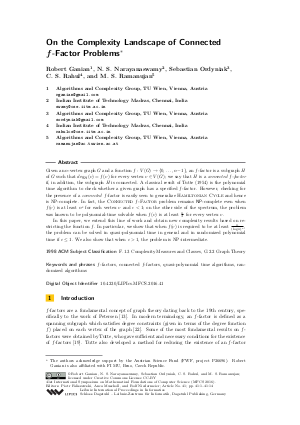On the Complexity Landscape of Connected f-Factor Problems
Authors Robert Ganian, N. S. Narayanaswamy, Sebastian Ordyniak, C. S. Rahul, M. S. Ramanujan
-
Part of:
Volume:
41st International Symposium on Mathematical Foundations of Computer Science (MFCS 2016)
Part of: Series: Leibniz International Proceedings in Informatics (LIPIcs)
Part of: Conference: Mathematical Foundations of Computer Science (MFCS) - License:
 Creative Commons Attribution 3.0 Unported license
Creative Commons Attribution 3.0 Unported license
- Publication Date: 2016-08-19
File

PDF
LIPIcs.MFCS.2016.41.pdf
- Filesize: 0.74 MB
- 14 pages
Document Identifiers
Subject Classification
Keywords
- f-factors
- connected f-factors
- quasi-polynomial time algorithms
- randomized algorithms
Metrics
- Access Statistics
-
Total Accesses (updated on a weekly basis)
0Document
0Metadata
Abstract
Given an n-vertex graph G and a function f:V(G) -> {0, ..., n-1}, an f-factor is a subgraph H of G such that deg_H(v)=f(v) for every vertex v in V(G); we say that H is a connected f-factor if, in addition, the subgraph H is connected. A classical result of Tutte (1954) is the polynomial time algorithm to check whether a given graph has a specified f-factor. However, checking for the presence of a connected f-factor is easily seen to generalize Hamiltonian Cycle and hence is NP-complete. In fact, the Connected f-Factor problem remains NP-complete even when f(v) is at least n^epsilon for each vertex v and epsilon<1; on the other side of the spectrum, the problem was known to be polynomial-time solvable when f(v) is at least n/3 for every vertex v.
In this paper, we extend this line of work and obtain new complexity results based on restricting the function f. In particular, we show that when f(v) is required to be at least n/(log n)^c, the problem can be solved in quasi-polynomial time in general and in randomized polynomial time if c <= 1. We also show that when c>1, the problem is NP-intermediate.
Cite As Get BibTex
Robert Ganian, N. S. Narayanaswamy, Sebastian Ordyniak, C. S. Rahul, and M. S. Ramanujan. On the Complexity Landscape of Connected f-Factor Problems. In 41st International Symposium on Mathematical Foundations of Computer Science (MFCS 2016). Leibniz International Proceedings in Informatics (LIPIcs), Volume 58, pp. 41:1-41:14, Schloss Dagstuhl – Leibniz-Zentrum für Informatik (2016)
https://doi.org/10.4230/LIPIcs.MFCS.2016.41
BibTex
@InProceedings{ganian_et_al:LIPIcs.MFCS.2016.41,
author = {Ganian, Robert and Narayanaswamy, N. S. and Ordyniak, Sebastian and Rahul, C. S. and Ramanujan, M. S.},
title = {{On the Complexity Landscape of Connected f-Factor Problems}},
booktitle = {41st International Symposium on Mathematical Foundations of Computer Science (MFCS 2016)},
pages = {41:1--41:14},
series = {Leibniz International Proceedings in Informatics (LIPIcs)},
ISBN = {978-3-95977-016-3},
ISSN = {1868-8969},
year = {2016},
volume = {58},
editor = {Faliszewski, Piotr and Muscholl, Anca and Niedermeier, Rolf},
publisher = {Schloss Dagstuhl -- Leibniz-Zentrum f{\"u}r Informatik},
address = {Dagstuhl, Germany},
URL = {https://drops.dagstuhl.de/entities/document/10.4230/LIPIcs.MFCS.2016.41},
URN = {urn:nbn:de:0030-drops-65013},
doi = {10.4230/LIPIcs.MFCS.2016.41},
annote = {Keywords: f-factors, connected f-factors, quasi-polynomial time algorithms, randomized algorithms}
}
Author Details
References
-
Jin Akiyama and Mikio Kano. Factors and factorizations of graphs—a survey. Journal of Graph Theory, 9(1):1-42, 1985.

-
F. Cheah and D. G. Corneil. The complexity of regular subgraph recognition. Discrete Applied Mathematics, 27(1-2):59-68, 1990.

-
FRK Chung and RL Graham. Recent results in graph decompositions. London Mathematical Society, Lecture Note Series, 52:103-123, 1981.

- Kamiel Cornelissen, Ruben Hoeksma, Bodo Manthey, N.S. Narayanaswamy, and C.S. Rahul. Approximability of connected factors. In Christos Kaklamanis and Kirk Pruhs, editors, Approximation and Online Algorithms, volume 8447 of Lecture Notes in Computer Science, pages 120-131. Springer International Publishing, 2014. URL: http://dx.doi.org/10.1007/978-3-319-08001-7_11.
-
Marek Cygan, Jesper Nederlof, Marcin Pilipczuk, Michal Pilipczuk, Johan M. M. van Rooij, and Jakub Onufry Wojtaszczyk. Solving connectivity problems parameterized by treewidth in single exponential time. In FOCS, pages 150-159, 2011.

-
Michael R. Garey and David S. Johnson. Computers and Intractability: A Guide to the Theory of NP-Completeness. W. H. Freeman and Company, 1979.

- Gregory Gutin, Magnus Wahlström, and Anders Yeo. Parameterized rural postman and conjoining bipartite matching problems. CoRR, abs/1308.2599, 2013. URL: http://arxiv.org/abs/1308.2599.
- Russell Impagliazzo, Ramamohan Paturi, and Francis Zane. Which problems have strongly exponential complexity? Journal of Computer and System Sciences, 63(4):512 - 530, 2001. URL: http://dx.doi.org/10.1006/jcss.2001.1774.
-
Tomáš Kaiser. A short proof of the tree-packing theorem. Discrete Mathematics, 312(10):1689-1691, 2012.

-
László Lovász. The factorization of graphs. ii. Acta Mathematica Academiae Scientiarum Hungarica, 23(1-2):223-246, 1972.

-
László Lovász. On determinants, matchings, and random algorithms. In L. Budach, editor, Fundamentals of Computation Theory FCT '79, pages 565-574, Berlin, 1979. Akademie-Verlag.

-
NS Narayanaswamy and CS Rahul. Approximation and exact algorithms for special cases of connected f-factors. In Computer Science-Theory and Applications, pages 350-363. Springer, 2015.

-
Julius Petersen. Die theorie der regulären graphs. Acta Mathematica, 15(1):193-220, 1891.

-
Geevarghese Philip and M. S. Ramanujan. Vertex exponential algorithms for connected f-factors. In 34th International Conference on Foundation of Software Technology and Theoretical Computer Science, FSTTCS 2014, December 15-17, 2014, New Delhi, India, pages 61-71, 2014.

-
Geevarghese Philip and MS Ramanujan. Vertex exponential algorithms for connected f-factors. In LIPIcs-Leibniz International Proceedings in Informatics, volume 29. Schloss Dagstuhl-Leibniz-Zentrum fuer Informatik, 2014.

-
M. D. Plummer. Graph factors and factorization: 1985-2003: a survey. Discrete Mathematics, 307(7):791-821, 2007.

-
J. T. Schwartz. Fast probabilistic algorithms for verification of polynomial identities. J. ACM, 27(4):701-717, October 1980.

- W. T. Tutte. A short proof of the factor theorem for finite graphs. Canadian Journal of Mathematics, 6(1954):347-352, 1954. URL: http://dx.doi.org/10.4153/CJM-1954-033-3.
-
WT Tutte. The factors of graphs. Canad. J. Math, 4(3):314-328, 1952.

-
Preben Dahl Vestergaard and Mekkia Kouider. Connected factors in graphs - a survey. Graphs and Combinatorics, 21(1):1-26, 2005.

-
Magnus Wahlström. Abusing the tutte matrix: An algebraic instance compression for the k-set-cycle problem. In STACS, pages 341-352, 2013.

-
D. B. West. Introduction to Graph Theory. Prentice Hall, 2001.

-
Richard Zippel. Probabilistic algorithms for sparse polynomials. In Symbolic and Algebraic Computation, volume 72, pages 216-226. 1979.

